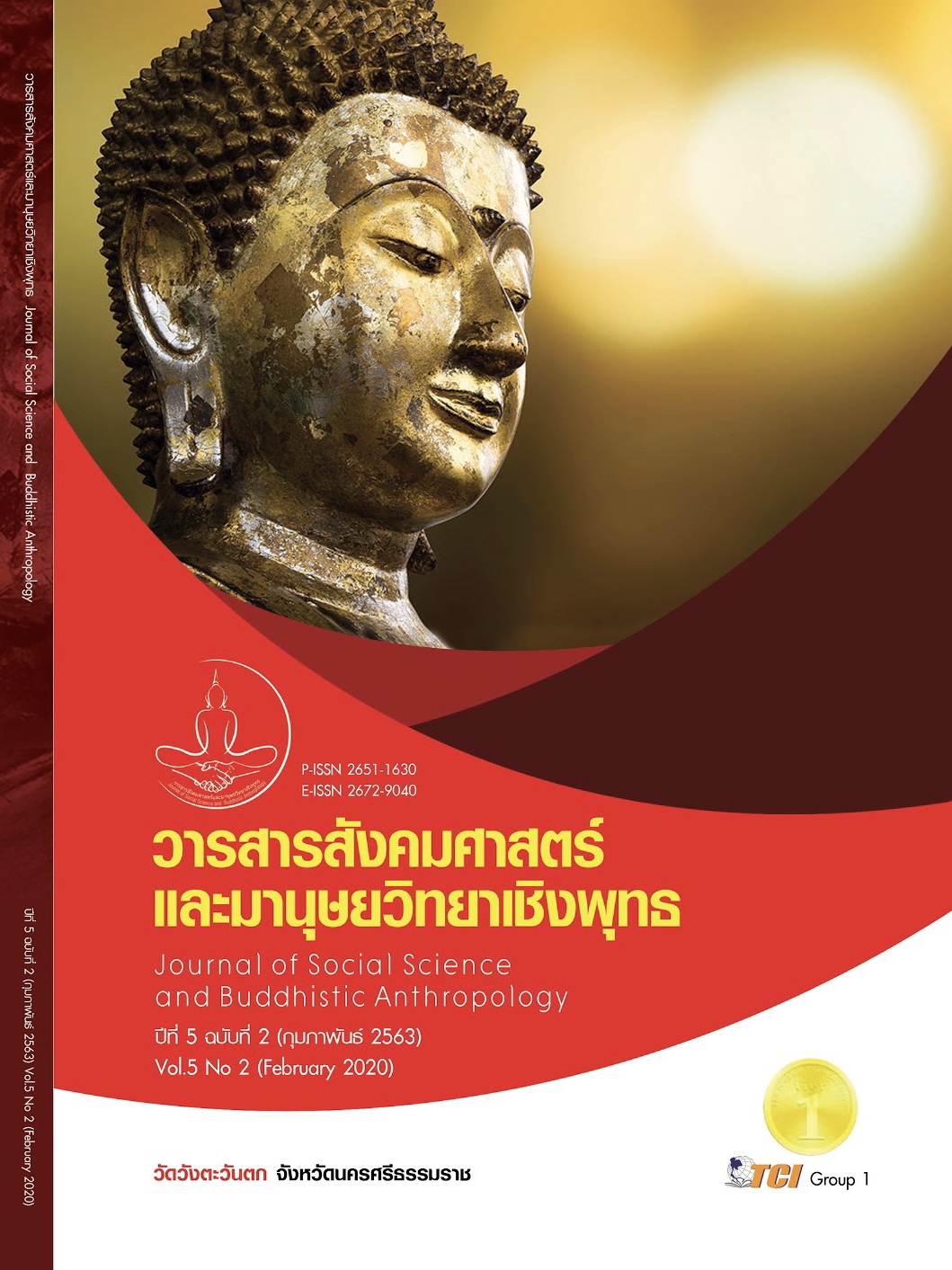BUDDHA’S ROLE FOR THE PROPAGATION OF DHARMA
Keywords:
Role, Buddha, The Propagation Of DharmaAbstract
This article aims to study the meaning of roles and propagation. The Buddha’s words of the Buddha that were propagated as well as the role of Buddha in the propagation of Dharma. In order to point out the service to the world of the Buddha, it is found that the role refers to the expression, behavior, or obligation of the person according to the status of the society. The propagation means announcement or extension. Therefore, the role of Dharma propagation means the Buddha is responsible for preaching or showing the Dharma to the world citizen. When considering Buddha’s words that were propagated, he realized to the difficulty and the basic of person characteristics that effects of the Dharma attainment as the lotus has four groups (the four types of people) and awareness for selection of the Dharma shown and the results of the Dharma. The maximum benefit is therefore received to those receiving justice. For the role of the Buddha in the propagation of Dharma, his highness played two important roles: the propagation of Dharma according to the Buddha’s conduct.The Buddha’s conduct, functions or services (Buddha-cariyā) for three purposes: Lokattha-cariyā, Ñātattha-cariyā and Buddhattha-cariyā, as the name of master, he performed duties in relief to the world. This is a duties that treats to the world along with 45 Phansa (period of three lunar months during the rainy season) . In addition, the guidelines for the propagation of the disciples by setting goals or policies for propagation of Dharma to the monks or missionaries to consider and the qualifications of the missionaries for setting the appropriate way of propagation. The role of the Buddha in the propagation of dharma should be a pattern of Buddha's lifetime and the Buddhist monk in present time.
References
กรมการศาสนา. (2535). วินัยบัญญัตินักธรรมชั้นตรี. กรุงเทพมหานคร: กรมการศาสนา.
กุศล โพธิ์สุวรรณ. (2556). ภาวะผู้นำการเผยแผ่พระพุทธศาสนาของพระมงคลเทพมุนี (สด จนฺทสโร). ใน ดุษฎีนิพนธ์พุทธศาสตรดุษฎีบัณฑิต สาขาวิชารัฐประศาสนศาสตร์. มหาวิทยาลัยมหาจุฬาลงกรณราชวิทยาลัย.
คูณ โทขันธ์. (2537). ศาสนาเปรียบเทียบ. กรุงเทพมหานคร: โอ. เอส. พริ้นติ้ง เฮ้าส์.
ดนัย ไชยโยธา. (2538). ลัทธิ ศาสนา และระบบความเชื่อกับประเพณีนิยมในท้องถิ่น. กรุงเทพมหานคร: โอ.เอส.พริ้นติ้ง เฮ้าส์.
เดือน คำดี. (2534). พุทธปรัชญา. กรุงเทพมหานคร: โอ.เอส.พริ้นติ้ง เฮ้าส์.
บุญมี แท่นแก้ว และคณะ. (2538). พุทธศาสตร์-ปรัชญา. (พิมพ์ครั้งที่ 3). กรุงเทพมหานคร: โอ. เอส. พริ้นติ้ง เฮ้าส์.
บุญมี แท่นแก้ว และอุดมลักษณ์ แท่นแก้ว. (2547). พระสงฆ์. กรุงเทพมหานคร: โอเดียนสโตร์.
ประยงค์ แสนบุราณ. (2557). พระพุทธศาสนาเถรวาท. ขอนแก่น: คลังนานาวิทยา.
ประยงค์ แสนบุราณ. (2559). พระพุทธศาสนากับนานาลัทธิและปรัชญา. ขอนแก่น: มหาวิทยาลัยขอนแก่น.
พระเทพเวที (ประยุทธ์ ปยุตฺโต). (2533). พจนานุกรมพุทธศาสน์ ฉบับประมวลศัพท์. (พิมพ์ครั้งที่ 6). กรุงเทพมหานคร: มหาจุฬาลงกรณราชวิทยาลัย.
พระพรหมคุณาภรณ์ (ป.อ. ปยุตฺโต). (2546). พจนานุกรมพุทธศาสตร์ ฉบับประมวลธรรม. (พิมพ์ครั้งที่ 12). กรุงเทพมหานคร: มหาจุฬาลงกรณราชวิทยาลัย.
พระพรหมคุณาภรณ์ (ป.อ. ปยุตฺโต). (2552). พุทธธรรม: ฉบับปรับปรุงและขยายความ. (พิมพ์ครั้งที่ 11). กรุงเทพมหานคร: มหาจุฬาลงกรณราชวิทยาลัย.
พระมหาอดิศร ถิรสีโล. (2552). พระพุทธศาสนาในอินเดียและต่างประเทศ. กรุงเทพมหานคร: จงเจริญ.
พุทธทาส อินฺทปญฺโญ. (2555). คู่มือมนุษย์. กรุงเทพมหานคร: พิมพ์ดี.
มหามกุฎราชวิทยาลัย. (2525). พระไตรปิฎกและอรรถกถาแปล ฉบับมหามกุฎราชวิทยาลัย ชุด 91 เล่ม. กรุงเทพมหานคร: มหามกุฎราชวิทยาลัย.
ราชบัณฑิตยสถาน. (2546). พจนานุกรม ฉบับราชบัณฑิตสถาน พ.ศ. 2542. กรุงเทพมหานคร: นามมีบุ๊คส์พับลิเคชั่นส์.
วศิน อินทสระ. (2558). เทคนิคการเผยแผ่พระศาสนา. กรุงเทพมหานคร: Canna graphic.
วิทย์ วิศทเวทย์. (2553). ปรัชญาทรรศน์: พุทธปรัชญา. ใน โครงการเผยแพร่ผลงานวิชาการ คณะอักษรศาสตร์ จุฬาลงกรณ์มหาวิทยาลัย. จุฬาลงกรณ์มหาวิทยาลัย.
ส. ศิวลักษณ์. (2542). ความเข้าใจในเรื่องพระรัตนตรัยจากมุมมองของ ส. ศิวลักษณ์. กรุงเทพมหานคร: เรือนแก้วการพิมพ์.
สนธยา พลศรี. (2545). หลักสังคมวิทยา=Principle of sociology. กรุงเทพมหานคร: โอเดียนสโตร์.
สมเด็จพระมหาสมณเจ้า กรมพระยาวชิรญาณวโรรส. (2557). พุทธประวัติ เล่ม 1. (พิมพ์ครั้งที่ 56). กรุงเทพมหานคร: มหามกุฎราชวิทยาลัย.
สุเชาว์ พลอยชุม. (2539). สารานุกรมพระพุทธศาสนา ประมวลจากพระนิพนธ์ สมเด็จพระมหาสมณเจ้า กรมพระยาวชิรญาณวโรรส. (พิมพ์ครั้งที่ 2). กรุงเทพมหานคร: มหามกุฎราชวิทยาลัย.
สุพัตรา สุภาพ. (2545). สังคมวิทยา. (พิมพ์ครั้งที่ 4). กรุงเทพมหานคร: ไทยวัฒนาพานิช.
เสฐียร พันธรังษี. (2526). ศาสนาเปรียบเทียบ. (พิมพ์ครั้งที่ 3). กรุงเทพมหานคร: ผดุงวิทยาการพิมพ์.
Biddle, B.J. (1986). Recent developments in role theory. Annual review of sociology, 12(1), 67-92.
Bierstedt, R. (1957). The social order. New York: McGraw-Hill.
Biesanz, J. & Biesanz, M. (1969). Introduction to sociology. Cliffs, N.J: Prentice-Hall.
Broom, L., & Selznick, P. (1968). Sociology: a text with adapted readings. New York: arper & Row, Publishers, Incorporated.
Goffman, E. (1961). Encounters. Indianapolis: Bobbs-Merrill.
Linton, R. (1936). The study of man: an introduction. New York: D. Appleton-Century.
Phillips, S. B. (1969). Sociology: social structure and change. New York: Macmillan.
Rocheblave-Spenlé, A. M. (1972). In Encyclopedia of psychology. New York: The Seabury.
Schaefer, T.R. (2004). Sociology: a brief introduction. New York: The McGraw-Hill.
Scott, J., & Marshall, G. (Ed.). (2009). A dictionary of sociology 3rd ed. Rev. New York: Oxford University.
Turner, H. J. (1994). Sociology: concepts and uses. New York: McGraw-Hill.








